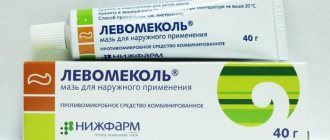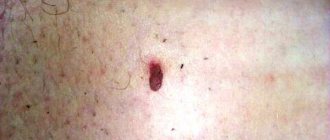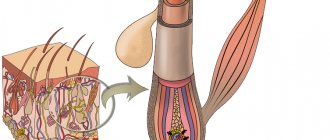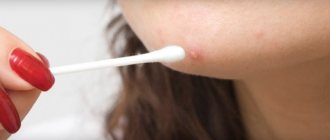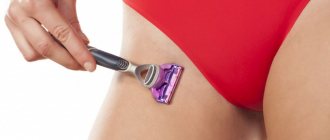Types of acne
The following types of acne may appear in the intimate area:
- White, compacted growths protruding above the surface of the skin. When pressed, pain is felt.
- Red pimples with a visualized purulent core. More often they are a symptom of an allergic reaction due to poor intimate hygiene. It manifests itself as itching and irritation of delicate skin in the sensitive area.
- Indurated pimples with watery contents. May indicate the presence of an infectious disease of the genital area.
- A Bartholin gland cyst is an accumulation of secretion at the mouth of the gland due to its clogging with vaginal secretion. It manifests itself as swelling in the inner area of the labia, discomfort when walking, palpating, or intercourse.
- Subcutaneous internal pimple (pimple). Formed due to clogging of the sebaceous gland by the epidermal layer. The released exudate is not removed outside, but accumulates and thickens. Over time, pus forms in the duct.
- Genital herpes. It appears during sexual contact with an infected carrier of herpes, decreased immunity, and infectious diseases. It manifests itself in the form of red ulcers, which are painful on palpation, and the lymph nodes in the intimate area are enlarged.
- Genital warts are often confused with acne due to their similarity. The disease is caused by the human papillomavirus, as well as a sexually transmitted infection.
- Acne inversion is a chronic disease of the sweat glands.
- Molluscum contagiosum is an acute viral infection that causes internal acne to appear in any part of the body. The area of the external genitalia is most often affected.
If any of the above acne is detected, you should immediately seek medical help to exclude the development of infection and timely treatment.
Causes
A large number of provoking factors are known, which is why a large purulent pimple appears on the body.
The main ones:
- Excessive secretion of sebum by the sebaceous glands. If the indicators are significantly exceeded, the ducts become clogged, which leads to purulent pimples appearing on the surface of the body.
- Hyperkeratosis. It is characterized by thickening of the stratum corneum of the skin; in addition, its increase is noted. The sebaceous glands become clogged with bacteria, which leads to inflammation and suppuration.
- Chaotic use of antibiotics. Has a detrimental effect on the condition of the skin. Certain medications cause the appearance of purulent pimples, called “medicinal acne.”
- Hormonal imbalance. In women during the menstrual cycle, during pregnancy or after. In many situations, 3-5 days before menstruation, the rash appears one-time or repeatedly.
- Inappropriate or excessive skin care. It often becomes a provoking factor in the occurrence of a purulent rash.
- Cosmetics of poor quality. Often provokes the formation of large purulent acne.
- Stress and psycho-emotional shocks. Prolonged nervous tension has an adverse effect on the condition of the skin.
Having established the provoking factor of the pathology, you can begin therapy.
On the face
The formation of large purulent pimples on the face is considered the most unpleasant. They may concentrate on the nose, cheeks, chin and near the forehead. This type of rash is characterized by an inflammatory process.
A red lump appears on the skin, which swells greatly and is accompanied by the accumulation of pus. This rash is very painful and causes psycho-emotional and physical discomfort.
The root cause must be identified. If treatment is not started on time, extremely adverse consequences appear in the form of scarring.
If compliance with hygiene rules and a review of nutrition are not crowned with a positive result, then this will be a reason for a visit to the doctor.
On the body
For appropriate therapy, it is necessary to establish what factors caused purulent acne on the body. The causes of the pathological process and treatment are directly interrelated and depend on the functioning of both. This applies to elements located under the skin and the rash itself.
On the labia
Large purulent pimples on the labia are considered a symptom of a malfunction in the female body.
Such a pathological process causes unpleasant discomfort, which disrupts overall well-being. There are quite a lot of provoking factors for their formation.
The most common is considered to be non-compliance with hygiene rules or their excessive implementation. This provokes minor trauma to the mucous membrane, where pathogenic microflora penetrates. If purulent pimples appear on the labia, you should immediately consult a doctor.
In the groin
Often a purulent rash occurs in the groin. The appearance of this pathology in the genital area is due to various circumstances.
The most common:
- failure to comply with hygiene rules;
- hypothermia;
- skin injuries;
- hormonal imbalance.
Often the appearance of large purulent pimples in the groin area indicates the presence of pathologies of sexually transmitted origin. When an inflammatory process is detected, you need to immediately visit a doctor.
On the butt
A purulent rash on the butt appears due to various reasons. It is necessary to take into account that acne cannot form and disappear on its own, so you need to find out what provokes its occurrence.
Pimples on the buttocks are formed due to:
- unbalanced nutrition, which negatively affects the dermis and internal organs;
- regular snacking on the go and excessive consumption of fatty foods;
- structural features of the buttocks, where there is a small number of sebaceous glands;
- skin irritability under the influence of external factors (constant friction);
- non-compliance with hygiene rules;
- sensitivity to various allergens;
- wearing tight-fitting clothes in the summer.
Large purulent pimples on the butt may indicate pathologies in the body and require urgent treatment.
Read all about the treatment of rosacea. How to treat whiteheads on the nose? More details here.
On the pubic area
This rash in the pubic area needs special attention, as it can be a signal of a systemic disease or an independent disease.
Purulent acne on the pubis appears due to various reasons:
- Shaving. It is a mechanical procedure that can cause injury to the skin. Cuts and injuries can cause infection.
- Boils. They are formed in the place where the hair follicles are located. The specificity of the microflora in intimate places only contributes to the acceleration of the proliferation of pathogenic microorganisms.
- Inadequate care of the skin in the groin. Provokes irritation, inflammation and other problems.
- Pediculosis pubis. It is caused by pubic lice. Often, such a disease is spread through sexual contact, but infection through clothing is possible.
- Genital herpes. It appears as small red pimples. This rash provokes intense itching, burning and swelling.
Causes of acne in the groin
The main reasons for the appearance of various acne in the groin of women are:
- Incorrect (insufficient) hygiene of the external genitalia.
- Use of low-quality personal hygiene products not approved by dermatologists and gynecologists: panty liners with chemical fragrances, dyes and fragrances; gels and lubricants to increase the sensitivity of the delicate area.
- Regular wearing of tight synthetic underwear, thongs. Due to poor ventilation of the delicate area, a “greenhouse effect” is formed, rashes appear, which over time turn into purulent pimples.
- Improper depilation, as a result of which ingrown hairs and wounds appear, and when infection gets into them, a pimple appears. If treatment is not done in a timely manner, pus will accumulate at the site of the ingrown hair.
- Hormonal imbalance (during pregnancy, menopause, puberty).
- Disturbed diet, abuse of fatty, smoked foods with large amounts of animal fats, salt and spicy spices.
- Allergic reactions to certain types of medications.
- Infectious sexually transmitted diseases (syphilis, gonorrhea, trichomoniasis, chlamydia, papillomavirus), vaginal candidiasis.
Only a gynecologist or dermatologist (dermatovenerologist) can determine the cause of the formation of rashes and purulent pimples in a woman’s intimate area. Therefore, it is strictly forbidden to self-medicate or squeeze out purulent contents from acne. The effectiveness and speed of treatment depends on timely seeking medical help.
Ulcers in the groin with furunculosis
The appearance of a single boil is not considered furunculosis.
This term is used in relation to patients in whom boils appear frequently and in large quantities.
Usually - in limited areas of the body, for example in the groin.
In severe cases, ulcers appear throughout the skin.
This is possible against the background of severe immune deficiency.
Furunculosis often manifests itself with general symptoms.
Body temperature can rise to 39 degrees or more.
The person feels unwell and complains of muscle pain and headache.
With a single abscess in the groin, such symptoms are also possible, but are less common.
Features of treatment
If subcutaneous, purulent pimples or wen are detected, urgent consultation with specialists is necessary. The disappearance of symptoms and a decrease in the size of the rash does not indicate independent treatment; the disease becomes chronic, gradually destroying the immune and reproductive systems.
Treatment of subcutaneous pimples (pimples) in the groin in women is carried out surgically - by opening the formation, washing the wound from the contents and treating it with disinfectants.
To treat a Bartholin gland cyst, the method of surgical excision (marsupialization) of the abscess is used with further installation of a word-catheter at the mouth of the gland. Followed by antibiotics.
Treatment of acne of allergic origin is carried out in several stages:
- Elimination of provoking factors (synthetic underwear, thongs, pads with fragrances, etc.),
- Careful personal hygiene using specially designed pharmaceutical products,
- Taking antihistamines and sedatives.
To treat genital psoriasis in women, symptomatic therapy is prescribed, which allows you to get rid of discomfort, itching, and other unpleasant symptoms. Symptomatic therapy involves taking:
- Local ointments (creams) with non-hormonal effects (Salicylic, Zinc ointments),
- Corticosteroid drugs (Hydrocortisone, Cortisone),
- Multivitamins, fish oil.
With normal immunity, molluscum contagiosum goes away on its own. However, in some cases surgery is required. The most commonly used methods are electrocoagulation, cryodestruction, and surgical excision.
Treatment of purulent acne in the groin in women includes:
- Antibacterial agents,
- Treatment and opening of pustules with subsequent treatment of the wound with disinfectant solutions,
- Application of wound-healing ointments, creams (Levomekol, metronidazole-based ointments, streptocidal ointment, etc.).
Purulent acne in the groin in women should be treated only in a medical setting. It is strictly forbidden to self-medicate for this type of rash, regardless of the reasons for its appearance.
Treatment of sexually transmitted diseases is carried out:
- Antibiotics in the form of tablets, injections. If there is an allergic reaction to penicillin, then antibiotics from the macrolide group, cephalosporins,
- Antiviral drugs (Valvir, Acyclovir, Vivorax),
- Immunomodulators (Immunal, Afalaza, Immudon).
The duration of treatment and an additional set of therapeutic measures are determined by the doctor, taking into account the duration of the disease, the degree of development of the disease, its form and severity.
The duration and effectiveness in the treatment of purulent, subcutaneous (internal) acne in the groin in women depends on the woman’s timely visit to a medical facility and the necessary tests (for HIV infection, TORCH, vaginal candidiasis).
Inflammation of atheroma in the groin
Atheroma is a sebaceous cyst.
It occurs when the excretory duct is blocked.
Secrets accumulate inside.
Then it thickens.
Inside there are drops of fat, cholesterol, and flakes of dead skin.
Very often such atheromas become inflamed.
Abscesses form in their place.
A chronic inflammatory process may form.
Then granulation growths appear in the walls of the atheroma.
Treatment of atheroma is carried out for medical or cosmetic reasons.
Getting rid of acne at home
If a woman rules out sexually transmitted diseases, you can get rid of some types of acne (except subcutaneous acne and Bartholin gland cysts) at home.
Before carrying out the procedures, you must thoroughly wash the groin area with acne with soap and water and rinse with warm boiled water. Dry with a clean towel, do not rub or stretch the damaged skin. Then you can use the following methods:
- For purulent acne, apply a thin layer of Vishnevsky, Ichthyol or Levomekol ointment to clean skin 2 times a day. If the lesions do not go away within 5-6 days of self-treatment, consultation with a dermatologist (gynecologist) is necessary.
- To dry the pustules and accelerate their maturation, apply a cotton swab soaked in iodine locally for 5-10 minutes. Carry out the procedure twice a day. As a rule, on the 3-4th day the purulent contents come out.
- Aloe applications. Pour boiling water over a freshly cut aloe leaf, cut off the top layer (film), edges and apply to the problem area for 3-4 hours, attaching it with a paper-based plaster. After 3-4 days of such applications, the pimple goes away.
You can use home remedies to treat acne in the groin area in women only after consulting a doctor. And also as an additional measure during drug therapy.
Treatment of a boil in the groin
Treatment depends on the stage of development of the disease. If you notice a boil at the first stage of its initial formation, then you need to apply a cotton swab with salicylic alcohol to the sore spot.
You need to lubricate the sore spot with alcohol several times during the day. The pimple can be lubricated with ichthyol ointment. To do this, you need to apply ichthyol ointment to sterile gauze bandages and apply them to the sore spot 3-4 times a day.
A good folk remedy is applying baked onions. It promotes rapid maturation of the abscess and drawing out pus.
The best way to deal with a boil in the groin is to see a doctor.
Your doctor may prescribe medication or surgery.
For furunculosis, doctors prescribe local treatment or antibiotic treatment.
Under no circumstances should you squeeze the boil, as this can lead to blood poisoning or the spread of inflammation to surrounding tissues.
Doctors recommend making compresses from ichthyol ointment. Thanks to the influence of ichthyol, the abscess quickly matures and opens. After spontaneous opening, the pus is removed with a sterile cotton swab moistened with alcohol. After this, bandages with ichthyol ointment or Vishnevsky ointment are applied to the wound.
The ointment draws out the remaining pus and promotes wound healing. With proper treatment, the abscess will heal completely and new boils will not appear.
The most effective method of treating a boil is the use of antibiotics. Treatment lasts about five days, while other treatments take at least ten days.
Doctors usually recommend dicloxacillin as antibiotics. It is very effective in such cases. Doctors often prescribe erythromycin or tetracycline.
In advanced cases of the disease, the doctor prescribes surgery. It is performed under local anesthesia, which minimizes pain. The surgical method of treatment allows you to eliminate the abscess very quickly.
The doctor cuts the surface of the boil, removes the pus and washes the wound with disinfectant solutions. After the operation, the wound is lubricated with ichthyol ointment or Vishnevsky ointment for several days, and antibiotics are also taken.
The use of ointment promotes rapid healing of the wound. Surgery may leave small scars.
Treatment becomes more effective if physiotherapeutic procedures are prescribed after surgery. The doctor usually prescribes UHF or electrophoresis with copper salts.
Doctors also prescribe patients a course of vitamin therapy and proteins. This treatment is prescribed to prevent complications and strengthen the immune system. To cure furunculosis with frequent or multiple appearance of ulcers, doctors sometimes prescribe a blood transfusion to the patient. This increases the body's defenses.
If a boil appears in the groin, it is necessary to undergo a full examination after treatment. A boil in the groin may indicate more serious illnesses. The appearance of an abscess can be caused by infectious diseases, frequent stress, poor diet, sedentary lifestyle, and allergic reactions.
Sometimes a boil in the groin may indicate that the patient has trichomoniasis and gonorrhea, so you need to be examined by a dermatovenerologist and, if necessary, undergo appropriate treatment.
Ulcers in the groin due to STDs
Most sexually transmitted infections do not cause groin ulcers.
There are only a few exceptions.
Genital herpes leads to the appearance of blisters with liquid in the groin area.
If secondary pyogenic flora is attached, the vesicles may suppurate.
Then the inside contains not a clear liquid, but pus.
Such rashes take much longer to heal.
They require additional use of antibacterial treatment.
Candidiasis - causes the appearance of ulcers in the groin, most often against the background of diaper rash.
Another risk factor is immunodeficiency.
In the area of inflammation, you can find red spots, white deposits with an unpleasant odor.
They are easy to remove.
Erosions, papules and ulcers appear.
As they heal, they become crusty.
Proper treatment of purulent acne on the pubic area
Ulcers in the groin and pubic area are a very delicate problem that requires an urgent solution, because not only your sex life, but also your health may be at risk.
And if small pimples on the pubis or in the groin often go away on their own, then ulcers are not to be trifled with.
The first thing you need to do is contact a dermatologist, or better yet, a dermatovenerologist. The doctor will determine the exact cause and give the necessary recommendations for treatment.
To recommend the use of any serious means for the treatment of ulcers on the pubic area and other, more intimate places, without establishing the exact cause would be quackery.
But something can and should be done now, namely: draw out the pus, soothe the skin, relieve inflammation and remove possible “provocateurs”. Here's what you can do for this:
- Aloe, sea water, potatoes, calendula tincture, ichthyol ointment, Vishnevsky ointment - all of them will help remove pus from a pimple (you will learn how to use them in the next article).
- We follow the rules of intimate hygiene and wash regularly. No comments. ?
- We change our underwear once a day. And one less potential threat.
- We wipe the pimples that have already appeared in the groin with chamomile-based products. This way we will prevent the emergence of new problems with ulcers.
- We increase immunity. Reducing stress levels, an active lifestyle, adequate sleep and nutrition - this is what will help boost immunity, which will help the skin get rid of ulcers.
- Never squeeze pimples. Also, you should not touch them often with your hands, so as not to aggravate the suppuration.
And I ask you, do not delay your visit to the doctor. These tips are helpful, but not a complete treatment for ulcers on the pubic area. If you have something serious, delaying may result in further health problems.
Women spend so much money, time and effort to ensure that the skin all over their body looks soft and silky. However, not everyone is able to achieve the desired result.
Sometimes pimples appear on the skin, this phenomenon is especially unpleasant in the bikini area and on the pubic area. Some rashes are not at all dangerous for a woman’s general health and are purely cosmetic in nature. But there are acne that are a symptom of serious diseases, and they need to be given maximum attention, as well as timely medical assistance.
Acne in the groin in women can have a different character and therefore can also look different. In any case, you need to be examined by a doctor, take the necessary tests so that a specialist can make a diagnosis and prescribe appropriate treatment.
Any pimples in the intimate area cause a woman a lot of inconvenience, regardless of the reason for their appearance. Therefore, having identified the cause, immediately begin to eliminate the problem. And there can be several reasons for the appearance of acne in the groin.
For example, in adolescents, rashes may appear due to hormonal changes throughout the body. If the pimples are white, this may be due to a malfunction of the sebaceous glands of a teenager or adult.
Also, acne on the pubic area in women often appears if you wear tight clothes, do not follow basic hygiene rules, or after inaccurate shaving.
A few words should be said separately about shaving. The razor removes the top layer of skin, making the delicate bikini area even more vulnerable to infection.
Therefore, girls who prefer shaving and depilation as a means of removing unwanted pubic hair must follow these simple rules:
- Take a bath or long shower before the hair removal procedure;
- The razor must be sharp, but be careful not to get hurt;
- Don't neglect cosmetics such as shaving gel or foam;
- Shave hairs in the direction of growth, and not vice versa;
- After depilation, do not forget to treat the bikini area with powder or aftershave cream, which will relieve inflammation.
There are some types of acne on the pubic area that indicate the presence of diseases that are transmitted through sexual intercourse:
- Condylomas are compacted formations on the skin that are flesh-colored or brown in color and feel either smooth or lumpy to the touch. Their size can reach two centimeters. In women, the rash appears in the perineum, anus, or labia. In men - on the penis, head, scrotum. The cause of the rash is the presence of the human papillomavirus in the patient. When pimples become inflamed, they can become red and itchy. Such acne cannot be treated at home; they are removed using electrocoagulation and cryodestruction procedures;
- Genital herpes is considered the most common cause of purulent rashes on the pubic area. The disease is transmitted through open sexual contact. The causative agent of the disease is the herpes virus. A few weeks after the virus enters the human body, watery pimples appear in the groin. The internal fluid is yellowish in color. The skin around the purulent rash turns red. The patient complains of severe pain, burning, itching, general malaise and lethargy. The rashes become filled with fluid until they rupture and turn into ulcers. With appropriate treatment, the sores will eventually become covered with a thin crust and heal. But remember that this tricky disease can return at any time. For example, it can be caused by stress, colds, a decreased immune system, hypothermia, and even hormonal imbalance. Unfortunately, the herpes virus cannot be removed from the body; it permanently settles in the human blood. Therefore, treatment of the disease is only temporary;
- Molluscum contagiosum – this disease can be contracted through sexual contact and through household items. The causative agent of the disease is poxvirus. After the incubation period, the patient notices large formations that are hard to the touch in the groin. They are pink in color and cone-shaped. Inside the pimples there is a cheesy content. The rash can be removed at your dermatologist's office. There are times when it goes away on its own;
- Pediculosis pubis is a disease caused by the presence of pubic lice in the patient. The patient complains of discomfort in the groin and itching. Severe scratching appears in the place where the louse bitten, and if infection gets into the wounds, this can lead to the appearance of ulcers. The skin on the pubis has an irritated red color;
- Syphilis is a disease that looks like a fairly large ulcer. The edges of the wound shine. In women, rashes occur on the pubis, vagina and labia. After some time, pinkish pimples appear at the site of the ulcer. You should not treat this disease yourself; contact a dermatovenerologist, he will prescribe correct and effective treatment.
In the bikini area, the skin is very thin, delicate and sensitive. Therefore, it is easy to injure it until wounds form. Infection penetrates into these wounds and rashes appear.
At first the rash is pink, then red and then suppurates. If pus appears, the pimples will break out on their own and heal. Under no circumstances should the rash be squeezed out. You risk getting an infection, and this will be followed by the appearance of large new abscesses in even greater numbers.
Pimples in the groin can be itchy and painful.
If the rash is filled with pus, this indicates a weak immune system, the presence of an infection, diabetes, or that you have recently experienced hypothermia. In these cases, large purulent pimples will not only hurt, but also have swelling. Such a rash may well cause high fever and enlarged lymph nodes in the intimate area.
If you delay treatment and develop a high fever as the disease develops, treatment will necessarily include antibiotics, ointments and vitamins that boost immunity.
If you have white rashes not only on the pubis, but also on the labia, the cause may be a blockage of the sebaceous glands. This rash is an internal pimple under the skin. When a fatty cyst becomes blocked, the internal rash increases and is very painful. These pimples also cannot be squeezed out on your own. It is better to contact a specialist who will prescribe you ointments that will help break through the abscess and cleanse the sebaceous canal.
As we have said many times, you should not delay your visit to the doctor. Trust the professionals in this delicate matter. Experienced doctors will identify the cause of acne and prescribe treatment.
There are diseases for which pharmaceutical products will help you, but there are also rashes that can actually be cured at home:
- For genital herpes, antiviral drugs such as Zovirax, Acyclovir and Bonafton are often prescribed. Complex treatment is considered the most effective, so along with ointments, vitamins are also prescribed to boost immunity;
- For pubic pediculosis, anti-pediculosis pharmaceutical drugs are used;
- Use Vishnevsky ointment, lubricate the rash in the evening before going to bed, cover it with gauze, and remove the ointment from the skin in the morning. Repeat the procedure until the acne is completely gone. The rash can be cured using the same method using Levomekol;
- Use an aloe leaf, glue its cut to the abscess using an adhesive plaster, repeat the procedure three times;
- After showering, treat acne with iodine or hydrogen peroxide.
To prevent pubic acne, we recommend following the rules of hygiene, not getting too cold, not being promiscuous, taking all precautions when shaving and depilating, and also carefully monitoring your hormonal levels.
But if the disease does appear, do not start it, do not squeeze out pimples, take the correct treatment prescribed by a specialist, and be healthy!
Share the link with your friends



